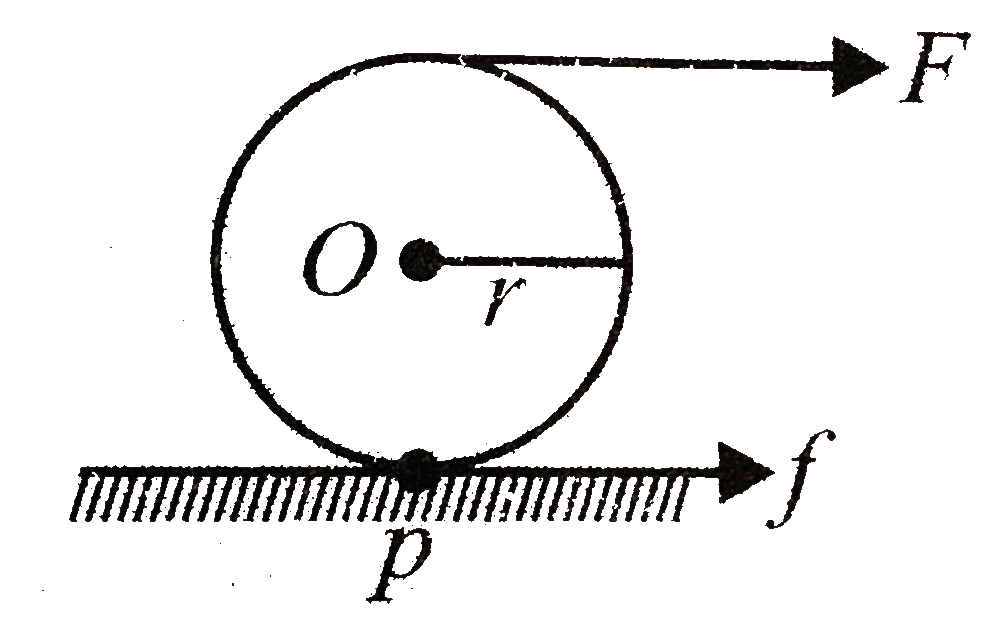Two uniform solid spheres having unequal radii are released from rest from the same height on a rough incline. the spheres roll without slipping
the heavier sphere reaches the bottom first
the bigger sphere reaches the bottom first
the two spheres reach the bottom together
the information given is not sufficient to tell which sphere will reach the bottom first
The correct Answer is:C
To solve the problem of two uniform solid spheres rolling down a rough incline without slipping, we will use the work-energy theorem and the relationship between linear and angular motion.
1. Understanding the Problem:
- We have two solid spheres of different radii released from the same height on a rough incline.
- They roll without slipping, meaning we can relate their linear velocity (v) and angular velocity (ω) using the equation v=rω.
2. Applying the Work-Energy Theorem:
- According to the work-energy theorem, the potential energy at the height (mgh) is converted into kinetic energy (both translational and rotational) as the spheres roll down the incline.
- The total kinetic energy (K.E) when the spheres reach the bottom is given by:
K.E=12mv2+12Iω2
- For a solid sphere, the moment of inertia I is given by:
I=25mr2
3. Substituting the Moment of Inertia:
- Substitute I into the kinetic energy equation:
K.E=12mv2+12(25mr2)ω2
- Using the relationship ω=vr, we can rewrite ω2 as v2r2:
K.E=12mv2+12(25mr2)(v2r2)
- This simplifies to:
K.E=12mv2+15mv2=(510+210)mv2=710mv2
4. Setting Up the Energy Equation:
- Now, equate the potential energy at the height to the total kinetic energy:
mgh=710mv2
- Cancel m from both sides:
gh=710v2
5. Solving for Linear Velocity (v):
- Rearranging gives:
v2=107gh
- Taking the square root:
v=√107gh
6. Acceleration of the Spheres:
- The acceleration a of the spheres can be derived from the forces acting on them:
a=gsinθ1+k
- Here, k is the rotational inertia factor, which is the same for both spheres since they are solid spheres.
7. Conclusion:
- Since both spheres have the same acceleration and start from the same height, they will reach the bottom of the incline at the same time.
Final Answer:
Both spheres will reach the bottom together.
- We have two solid spheres of different radii released from the same height on a rough incline.
- They roll without slipping, meaning we can relate their linear velocity (v) and angular velocity (ω) using the equation v=rω.
- According to the work-energy theorem, the potential energy at the height (mgh) is converted into kinetic energy (both translational and rotational) as the spheres roll down the incline.
- The total kinetic energy (K.E) when the spheres reach the bottom is given by:
K.E=12mv2+12Iω2
- For a solid sphere, the moment of inertia I is given by:
I=25mr2
- Substitute I into the kinetic energy equation:
K.E=12mv2+12(25mr2)ω2
- Using the relationship ω=vr, we can rewrite ω2 as v2r2:
K.E=12mv2+12(25mr2)(v2r2)
- This simplifies to:
K.E=12mv2+15mv2=(510+210)mv2=710mv2
- Now, equate the potential energy at the height to the total kinetic energy:
mgh=710mv2
- Cancel m from both sides:
gh=710v2
- Rearranging gives:
v2=107gh
- Taking the square root:
v=√107gh
- The acceleration a of the spheres can be derived from the forces acting on them:
a=gsinθ1+k
- Here, k is the rotational inertia factor, which is the same for both spheres since they are solid spheres.
- Since both spheres have the same acceleration and start from the same height, they will reach the bottom of the incline at the same time.
Both spheres will reach the bottom together.
Topper's Solved these Questions
- ROTATIONBOOK - DC PANDEY ENGLISHCHAPTER - ROTATIONEXERCISE - (A) Chapter Exercises
83 Videos
- ROTATIONBOOK - DC PANDEY ENGLISHCHAPTER - ROTATIONEXERCISE - (B) Chapter Exercises
25 Videos
- ROTATIONBOOK - DC PANDEY ENGLISHCHAPTER - ROTATIONEXERCISE - Check point 9.2
20 Videos
- RAY OPTICSBOOK - DC PANDEY ENGLISHCHAPTER - RAY OPTICSEXERCISE - Integer type q.
14 Videos
- ROTATIONAL MECHANICSBOOK - DC PANDEY ENGLISHCHAPTER - ROTATIONAL MECHANICSEXERCISE - Subjective Questions
2 Videos
Similar Questions
Two uniform solid spheres having unequal radii are released from rest from the same height on a rough incline. If the spheres roll without slipping
View SolutionA solid cylinder and a hollow cylinder, both of the same mass and same external diameter are released from the same height at the same time on an inclined plane. Both roll down without slipping. Which one will reach the bottom first ?
View SolutionA ring,solid sphere and a disc are rolling down from the top of the same height, then the sequence to reach on the surface is
View SolutionA force F acts tangentially at the highest point of a sphere f mass m kept on a rough horizontal plane. If the sphere rolls without slipping, find the acceleration of the centre of the sphere.

View SolutionA ring, cylinder and solid sphere are placed on the top of a rough incline on which the sphere can just roll without slipping. When all of them are released at the same instant from the same position, then
View SolutionA hollow sphere and a solid sphere having same mass and same radii are rolled down a rough inclined plane.
View SolutionA hollow sphere is released from top of an inclined plane of inclination 30º and length of inclined plane is /. If sphere rolls without slipping then its speed at bottom is
View SolutionAssertion : A solid sphere and a ring of same mass and radius are released simultaneously from the top of an inclined surface. The two objects roll down the plane without slipping. They reach the bottom of the incline with equal linear speeds
Reason : Decrease in potential enery for both is the same.
View SolutionA solid sphere rolls down two different inclined planes of the same height but of different inclinations
View SolutionA solid sphere rolls down two different inclined planes of the same height but of different inclinations
View Solution
